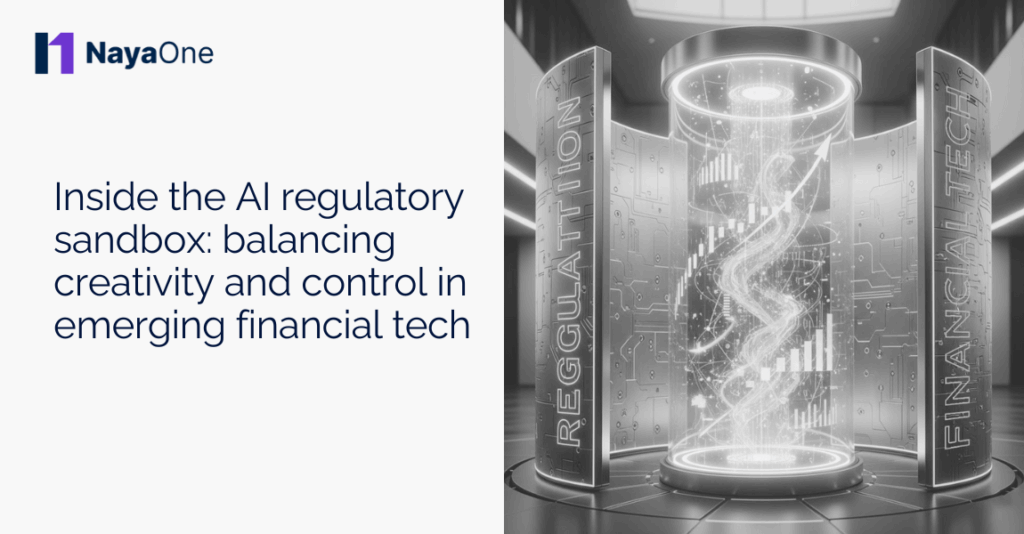Emerging financial technology firms have a tough gig. They want to innovate quickly, using the power of AI to transform everything from lending decisions to fraud detection. But the moment they step into the world of regulation, things get complicated. Rules around data privacy, fairness, transparency and accountability can feel like hurdles slowing innovation to a crawl.
That’s where the AI regulatory sandbox comes in. It offers a controlled playground where fintech companies can test new AI-driven products and models with real customers, but without the full regulatory burden right away. This gives them the freedom to experiment, fail fast, and improve, while regulators keep a close eye to ensure everything stays on the right side of compliance.
Regulatory complexity is a significant burden: in a recent survey of 451 global fintech executives, nearly 40% said evolving regulation is one of the biggest forces affecting their business.
So, how exactly does this sandbox balance creativity with control? Let’s take a closer look.
How does a regulatory sandbox create a safe space for financial tech innovation?
Imagine a space where fintech innovators can push boundaries but still have a safety net underneath. That’s exactly what an AI regulatory sandbox provides. Rather than waiting years for full regulatory approval, companies get the chance to test their AI solutions in a live but closely monitored environment.
In this sandbox, regulatory authorities often loosen some requirements temporarily or provide clear guidelines on what’s expected during the testing phase. The sandbox acts like a trial run, offering early feedback, spotting potential compliance gaps and encouraging iterative improvements.
For example, a fintech startup developing an AI-powered credit scoring system could test its model with a limited group of users inside the sandbox. Regulators can observe how the AI makes decisions, ensuring it does not unfairly discriminate based on age, gender, or ethnicity. Meanwhile, the startup gains invaluable insights on how to refine its algorithms before a full market release.
The key benefit? Innovators can take creative risks that would be too risky under normal circumstances, knowing they have expert oversight to guide them. It’s a win-win: regulators learn about new tech firsthand, and fintechs develop better products faster.
What compliance challenges do financial tech firms face when deploying AI?
Emerging financial tech firms are juggling a lot. AI models need to be powerful and efficient, but they also have to meet strict regulatory standards. Some of the biggest challenges include:
- Data privacy: How to use customer data ethically without breaching privacy laws.
- Fairness: Avoiding bias that might discriminate against certain groups, intentionally or not.
- Transparency: Explaining AI decisions clearly to customers and regulators.
- Accountability: Proving who is responsible if the AI makes a mistake or causes harm.
Without an AI regulatory sandbox, these challenges can feel overwhelming, especially for startups with limited resources. The sandbox helps by creating a framework where these issues can be addressed early and openly, reducing costly surprises later on.
Let’s dig a little deeper into each.
Data privacy remains a hot-button issue, especially with regulations like GDPR and the UK’s Data Protection Act. AI models need lots of data to learn, but collecting and using that data without consent or proper safeguards can land firms in hot water. A sandbox lets firms test data handling procedures in a compliant way before rolling out to a wider audience.
Fairness is another tricky area. AI systems often reflect biases present in their training data, sometimes unintentionally discriminating against minorities or vulnerable groups. Regulators are increasingly demanding fairness audits and bias mitigation plans, which firms can trial inside a sandbox.
Transparency means being able to explain how AI decisions are made. This is vital for customer trust and regulatory approval. In a sandbox, firms can practise generating clear explanations and work with regulators on what level of transparency is acceptable.
Accountability ties everything together. If an AI makes a wrong decision, who is responsible? The firm? The developer? The regulator? Sandboxes help clarify these lines through real-world tests and collaborative rule-making.
How does the sandbox model encourage responsible AI development?
The AI regulatory sandbox is more than just a testing ground; it’s a collaboration hub between innovators and regulators. Instead of working in isolation, fintech firms get ongoing feedback from regulatory bodies throughout the development process.
This iterative approach means AI models are continuously refined with compliance in mind. Regulators can monitor key metrics, assess risk, and provide guidance on necessary adjustments. It helps companies build trust by demonstrating their commitment to responsible AI from day one.
One fintech firm, for instance, used the sandbox to test an AI-driven anti-money laundering system. Regulators helped identify blind spots where the AI failed to flag suspicious activity, allowing the firm to adjust its algorithms promptly. This cooperation meant the final product was much more robust and trustworthy.
Plus, because data and processes are tracked closely, firms can generate detailed documentation for audits and future reviews, making formal validation much smoother.
Another advantage is that sandboxes often encourage transparency between stakeholders, reducing misunderstandings. The collaborative environment fosters a culture where responsible AI is not an afterthought but a core design principle.
Why is balancing creativity and control critical for the future of financial tech?
Too much control, and innovation grinds to a halt. Too little oversight, and financial tech risks regulatory backlash, fines or reputational damage. Striking the right balance is essential for growth.
The regulatory sandbox helps find this middle ground. It allows fintech firms to explore new ideas boldly but within boundaries designed to protect consumers and markets. This balance encourages a healthy innovation cycle; products evolve quickly but responsibly.
Think about it: if firms fear regulators will shut them down, they’ll avoid riskier but potentially game-changing innovations. On the other hand, unchecked AI can cause serious harm, from biased loan approvals to missed fraud detection.
By using sandboxes, regulators get early visibility and can shape AI development before problems become entrenched. Firms get the flexibility they need, while consumers benefit from safer, fairer financial products.
In a sector where trust is everything, finding ways to innovate without compromising safety or ethics will separate the winners from the also-rans.
Can regulatory sandboxes unlock the full potential of financial tech innovation?
The case for AI regulatory sandboxes is compelling. They offer a unique opportunity to merge creativity with compliance, enabling financial technology companies to innovate rapidly while managing risks effectively.
As regulators and fintechs continue to work hand in hand, these sandboxes could well be the key to unlocking new AI-driven solutions that are both groundbreaking and trustworthy. For anyone involved in emerging financial technology, paying attention to AI regulatory sandboxes is no longer optional; it’s essential.
If you’re a fintech innovator, regulator, or investor, now is the time to explore how sandbox frameworks can accelerate your AI journey safely and responsibly. The future of financial tech depends on it.
The AI sandbox provides more than just a testing environment; it fosters a culture of collaboration and transparency between innovators and regulators. By offering a space to experiment within defined boundaries, the AI sandbox helps ensure new technologies meet ethical and legal standards from the outset. This proactive approach reduces costly setbacks down the line and builds confidence among customers and stakeholders alike, making it an indispensable tool for the future of financial technology.






